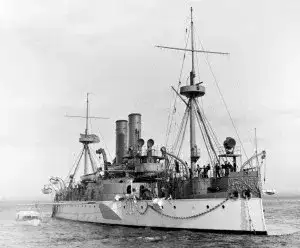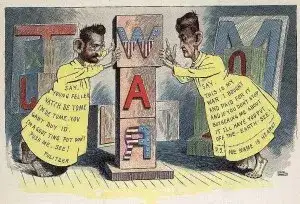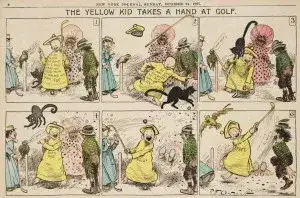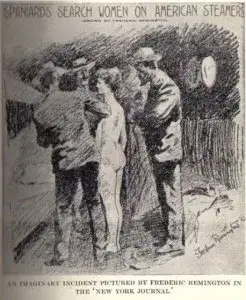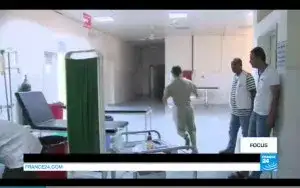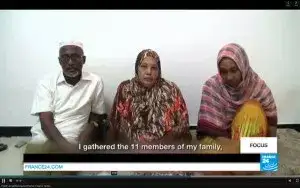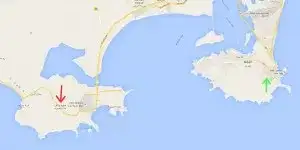A special place in hell
August 25, 2023 by Thomas Wictor
My mother’s favorite expression was, “There’s a special place in hell for—” Then she’d mentioned someone who’d abused their trust. Teachers or clerics who abused children. Cops who took bribes from criminals. Politicians who lived lives of corruption and debauchery while piously broadcasting their churchiness. Personally, I hope there’s a special place in hell for journalists who lie.
“Yellow journalism” is defined as crude sensationalism designed to appeal to emotions. Operation Protective Edge seemed to be peak yellow journalism, but in some ways the wild exaggerations and outright lies coming out of Yemen are surpassing those reported during the Israeli war on Palestinian terrorists.
Journalists have become so dishonest that they can’t even tell the truth about yellow journalism.
American yellow journalism of the late 19th century, led by the newspapers of William Randolph Hearst, has been often blamed for bringing on the Spanish-American War, which began 112 years ago this month.
It is an enduring media-driven myth, a misleading, media-centric interpretation that refuses to die, despite considerable evidence to the contrary.
On February 15, 1898, the armored cruiser USS Maine exploded in Havana Harbor.
Of the 355-member crew, 251 were killed. On March 21, 1898, a US Navy board of inquiry concluded unanimously that the Maine was sunk by a mine detonated beneath the ship. Though Spain wasn’t specifically blamed, on April 20, 1898, the US sent an ultimatum to Spain demanding that Cuba be granted independence. Spain refused, so the US blockaded Cuba. This led to a Spanish declaration of war on April 23, followed by the American declaration on April 25. The Spanish-American War ended in an armistice on August 12, 1898, the formal peace treaty signed on December 10, 1898.
We read above that it’s an enduring myth that the press helped create the Spanish-American war. Well, here’s a cartoon from June 29, 1898.
It shows newspapermen Joseph Pulitzer on the left and William Randolph Hearst on the right fighting over toy blocks that spell out “WAR.” Both Pulitzer and Hearst are dressed as the Yellow Kid, a ghastly character from the comic strip Hogan’s Alley.
This nightmare for blockheads was hugely popular, leading Hearst to lure cartoonist Richard F. Outcault away from Pulitzer’s New York World newspaper. The acrimonious and public bidding war over Outcault led to the coinage of the term “yellow journalism” in 1897, based on that hideous kid.
So you can see that in June of 1898, it was already recognized that Pulitzer and Hearst had stoked the flames of war with yellow journalism. They accused the Spanish of blowing up the USS Maine and published lurid accounts of Spanish mistreatment of Cubans and American women.
It’s almost certain that the Maine exploded due to a design flaw: The coal bunker could overheat, causing spontaneous combustion. This bunker was located right next to the ship’s magazine, where all the powder and shells were stored. An undetected fire in the coal bunker was the likely cause of the explosion.
The yellow journalism of 1898 was used to sell newspapers and garner enough power to influence geopolitics. Today’s yellow journalism is about making money and positioning oneself as possessing moral superiority. There are two tenets of modern yellow journalism.
a. All Muslim terrorists have legitimate grievances.
b. All wars fought against Muslim terrorists are genocide.
Reports coming out of Yemen are the worst I’ve seen. First, it’s clear that every single “human rights” and aid organization is lying. They’ve been bought off by Iran. I see no evidence whatsoever of a catastrophic humanitarian disaster in Yemen.
The hospitals are clean, modern, and empty.
Every Yemeni is clean and well fed.
Now the reporting about the military campaign itself has hit bottom.
The U.S.-Backed War in Yemen Is Strengthening al Qaeda
When the Saudis hit Yemen, the idea was to knock back Iran’s proxies. But the real winner in the fight seems to be al Qaeda’s deadliest affiliate.
The U.S.-backed war in Yemen has strengthened al Qaeda there, American defense officials concede, posing a serious threat to U.S. security.
Months into the U.S.-supported Saudi intervention in Yemen, fighters linked to al Qaeda in the Arabian Peninsula (AQAP), long considered the terror group’s deadliest franchise, are closing on the southern port city of Aden, according to U.S. officials and local reports…
Not only is Saudi Arabia failing to stop the group’s expansion, but some fear the kingdom is colluding with AQAP to fight the Houthis, Iranian-backed rebels whom Saudi Arabia considers a bigger threat. Indeed, there have been reports that AQAP and Saudi Arabia worked together in the initial efforts last month to push the Houthis out of Aden…
In the last few days, reports have emerged suggesting al Qaeda controls the city’s port, Aden’s commercial center, known as Crater, and Tawahi district, which holds a presidential palace. Just north of the city, in Dar Saad, roughly 200 al Qaeda fighters are training in what was once an army base.
Where to start?
Al-Qaeda in the Arabian Peninsula (AQAP) is a deadly enemy of the House of Saud and is dedicated to overthrowing it. AQAP has carried out multiple attacks in Saudi Arabia. The Saudis have assembled a coalition of the most highly trained special operators on earth. Why on earth would they need AQAP to help fight these khat-chewing weirdos?
On May 13, 2014, the Saudis arrested sixty-two members of AQAP who were about to launch a huge assassination and terrorism campaign in the kingdom. It’s common knowledge that AQAP hates the House of Saud.
Also, Nancy Youssef of the Daily Beast clearly knows nothing about military matters. The Coalition landed over 1000 armored vehicles in Little Aden (red arrow), Crater (green arrow), and a temporary port built in about 48 hours.
These ports are vital to resupplying the Coalition and bringing in aid for all those plump Yemenis. Therefore, the ports are heavily guarded. The chances that AQAP took over the port in Aden are nonexistent. This is a lie fed to Nancy Youssef by Iran.
While Nancy Youssef reported that AQAP has taken over Aden and Tawahi, this is what the New York Times said.
Al Qaeda Fighters Try to Seize Yemeni Military Base in Aden
MAHRA, Yemen — Dozens of fighters belonging to Al Qaeda’s Yemeni affiliate briefly tried to seize control of a military base and the presidential palace in the port city of Aden before suddenly withdrawing on Sunday, according to local fighters and a senior military official in the city.
By Sunday afternoon, there were no signs of Qaeda militants in Tawahi, the neighborhood surrounding the palace…
On Sunday, a senior military official aligned with the anti-Houthi forces acknowledged the entrance of about 100 Qaeda fighters into Tawahi and said they had been the subject of a local security committee meeting. The official requested anonymity because he was not authorized to speak to journalists.
It was unclear whether the Qaeda fighters left because of an agreement with local commanders, or because they were trying to avoid an armed confrontation. On Sunday, local southern separatists took total control of Tawahi, said Abdul Wahab Al-Boujah, a local fighter who was guarding a checkpoint there.
The Southern Resistance and armed civilians held out against tens of thousands of Houthis for almost four months, supported by Coalition naval gunfire and air strikes. Do you think those people would’ve surrendered to 100 al-Qaeda? Or do you think they picked up their weapons and went looking for al-Qaeda?
Here’s a completely deranged report from Reuters.
Al Qaeda militants took control of a western district of Yemen’s main port city of Aden on Saturday night, residents said, in another sign that the group is drawing strength from five months of civil war.
The entrance of Al Qaeda in the Arabian Peninsula into Aden, once one of the world’s busiest ports and the most secular and secure parts of an otherwise restive country, would be one of its biggest gains yet.
“Dozens of al Qaeda militants were patrolling the streets with their weapons in total freedom in a number of areas in Tawahi. At the same time, others raised the al Qaeda black flag above government buildings,” a resident told Reuters.
He said the flag was also flying over the administrative building of the port, although a port official later said that the flag was flying at the gate of the port’s complex.
United Arab Emirates forces based in Aden meanwhile freed a British hostage who had been held by the group, the UAE state news agency WAM said on Sunday…
Britain’s Foreign Office confirmed in a statement that the hostage was “extracted by UAE forces in a military intelligence operation” and was “safe and well.”
So, al-Qaeda has taken over Aden, but UAE forces based in the city mounted a military operation to rescue a British hostage from al-Qaeda. At least Reuters admits that the UAE has forces based in Aden, which therefore disproves the claim that al-Qaeda has taken over the city. As does the MILITARY HOSTAGE RESCUE. The former hostage—Robert Douglas Semple—hasn’t described the rescue.
And, as of course I knew, al-Qaeda is being killed.
Emirati troops are on the ground in Yemen and the U.A.E. has provided support and equipment to coalition forces fighting the Houthis, said a person with knowledge of the troop deployment, who asked not to be identified because they’re not authorized to speak on the issue.
The U.A.E. is also trying and has had some success in persuading tribes and supporters of former President Ali Abdullah Saleh, who is allied with the Houthis, to join the coalition, said the person, who has been briefed on the matter. Those tribes needed to be reassured of a sustained security presence on the ground, the person said.
While the focus is on Houthi rebels, the U.A.E. will also act against al-Qaeda selectively if it obtains relevant intelligence, the person said.
And then another piece of information falls into place.
The coalition is increasing its presence on the ground and material support, as well as inserting overseas-trained Yemeni fighters into the conflict, said Graham Griffiths, an analyst at Control Risks in Dubai.
Overseas-trained Yemeni fighters. This is the first I’ve heard of that.
Since today’s yellow journalism is based on ritualized displays of sanctimony, we’re told that any death of a civilian is a war crime, and if even one soldier is killed fighting terrorism, that means that the entire effort has failed.
Nobody ever makes these people eat their words when they’re proven wrong, over and over and over again.
If things go the way I expect, I’ll use my blog to serve up a giant buffet for buffoons.
This article viewed 501 times.

